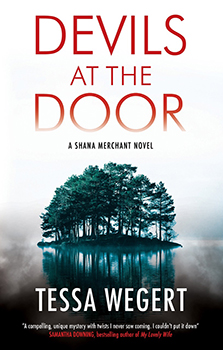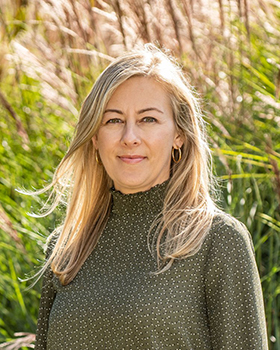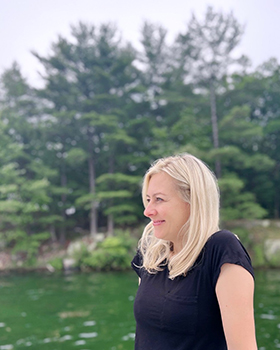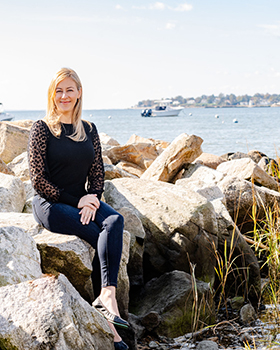Evil: Nature, Nurture, or Somewhere In Between?
The Big Thrill Interviews Tessa Wegert

In Tessa Wegert’s fifth novel in the Shana Merchant series, DEVILS AT THE DOOR, Shana’s life has been thrown off balance, and she’s twisted around her own trauma and anxiety. Shana is trying to heal while living with the notoriety following her after her harrowing experiences in the previous novel, The Kind to Kill.
On top of that, her brother Doug has asked Shana and her fiancé Tim to care for his daughter Henrietta during the fall semester. Hen’s been exhibiting destructive and troubling behavior, and Doug is sure that getting Hen into a new environment might be just what she needs to help turn her attitude around.
But Hen’s just as secretive and deceptive with Shana as she is with her parents, and Shana’s hopes for being Hen’s safe harbor plummet when she’s called to the scene of a mysterious drowning only to find her niece sitting with the body.

© Hildi Todrin/Crane Song Photography
The Big Thrill was pleased to speak with Wegert about nature versus nurture and the ethics of true crime.
You wrote your first book, Death in the Family, as a standalone novel. Did you find it challenging to transform Shana Merchant from a one-time character to developing her story into a series arc spanning five novels?
That’s a good question. Honestly, it felt like a pretty low-pressure situation at the beginning. I was happy to sell one book, and then when they came along and said, “How about two?” I had to think, “What can I do with this character to make her interesting?”
I certainly had no idea the series would reach six books ultimately, so I didn’t really think about [her growth arc] all that much. I took it one book at a time. I did end up taking part of the first book and making it the beginning of the second book to create a transition so that it felt like the beginning of a series. But, otherwise, I don’t know from one book to the next what I’m going to be writing about, what aspect of her life and her little universe in the Thousand Islands I’m going to dig into.
Where did the idea for DEVILS AT THE DOOR come from?
I have a kind of cinematic approach to writing. I see it like a filmstrip in my mind. I try to visualize the creepiest possible place for the crime scene, so this time, I knew I wanted it to be Devils Door Island, which is a real place. It’s a tiny little, uninhabited place that used to be where teenagers would go and party because of its close proximity to the mainland. It seemed like the perfect place [to set the crime scene].
I had already introduced Henrietta, the niece, as a character [in a previous book]. And at the beginning of DEVILS AT THE DOOR, Shana is at a point in her life where things can go really well for her, or they can go…in the wrong direction. She’s terrified of being at this crossroads and really wants to move her personal relationship forward and find happiness. But she has a lot of guilt and isn’t entirely convinced she deserves it. I [wanted to] bring in a vulnerable kid and create a scenario where you question whether or not you can trust someone close to you. [Shana’s] relationship with Henrietta provided an opportunity to do all those things.
Shana’s niece Henrietta (Hen) is having issues at home and comes to stay with Shana and Tim. Hen is questioning whether evil is learned or genetic/inherited, which seems to be a major theme in DEVILS AT THE DOOR. Do you think this question of “nature vs. nurture” is something a lot of people wrestle with?

I think it is. It’s something that’s come up in previous books in the series because Shana has grappled with that herself. She, too, has this blood tie to a notorious killer, but…I think a teenager is less likely to be able to look at it objectively. Kids that age are often struggling with their own sense of identity and struggling to find their place in the world and figure out who they really are.
[Hen’s] somebody wrestling with a fundamental core principle about who they are and who they’re going to grow into. And then [she’s] faced with this giant revelation that she has ties to this horrible, horrible person who did horrible things. She’s coming from one small town to another—the frying pan into the fire, basically—because where she moves to is the place that also has very personal experiences with this man.Mia, one of Hen’s new friends, runs a ghost tour and uses Shana’s trauma to make money. This isn’t unlike the true crime podcasts that have flourished in the last six years. Some have showcased the procedural aspects of the investigation, while others have tried to act as voices of the victims. Where do you stand on the issue of ethics around true crime?
This culture of obsession with violent crime and serial killers that we’re currently dealing with as a society definitely plays a big part in my books. It was huge in the previous book, The Kind to Kill, and then I touch on it here, too. I personally am pretty uncomfortable with this obsession. I do worry that what we’re doing is giving the killer a voice and, in a way, rewarding that kind of behavior.
In a few interviews, you’ve said that Agatha Christie and Louise Penny influenced your writing. What is it about these writers you’ve tried to emulate?
What I have always liked about Agatha Christie’s books is so many of them involve this closed circle of suspects. The other thing I like about Christie’s work is it’s not so much a “who done it” as a “why done it,” and that’s where the psychological fiction comes in.

© Hildi Todrin/Crane Song Photography
I think she (I’m sure that this has been noted before) was one of the original psychological fiction or psychological thriller authors because she delves so much into motive. She was very, very good at creating these high-concept crimes, but there was always a believable motive behind them, and that’s what most interests me.
With Louise Penny, it’s a little bit of a personal interest because I grew up in the Eastern Townships, where Louise Penny’s Three Pines series is based. But more than anything else, what attracts me to her books is Inspector Armand Gamache. To some extent, I modeled Shana on him because he, too, has a vulnerable side. If you’ve read all the books in the series, you know he made a lot of mistakes. He isn’t always well-liked, but those who know him respect him. He has a reason for doing what he does, but I love that it can take a long time for the reader to understand what those motives are. And that’s what I try to do with Shana.
What’s next?
The sixth Shana Merchant book is coming out in November 2024. It’s set on a fictional version of a real 5,300-acre island off the shore of Clayton in that same area where Shana lives. It’s about a very small community of people who overwinter on this quite large island and a crime that occurs there. It’s a bit of a return to the classic locked room mystery because crossing that river in winter can be deadly, so not many people [travel to the island].
The Big Thrill Interviews Tessa Wegert










